The Importance Of Trimming Split Ends
Understand why you shouldn’t ignore the split ends and take care of them ASAP!

Image: Shutterstock
Many of us do not talk about the importance of trimming split ends. But do you know that these tiny split ends can affect your hair growth and rob its bouncy and luscious look if not managed properly? Not only that, but they also make your hair texture dry and dull. Therefore, split ends should be taken care of and kept at bay to avoid these hair issues. From the article below, check out the major triggers of split ends and ways to stop them. Scroll down to read!
In This Article
What Causes Split Ends?
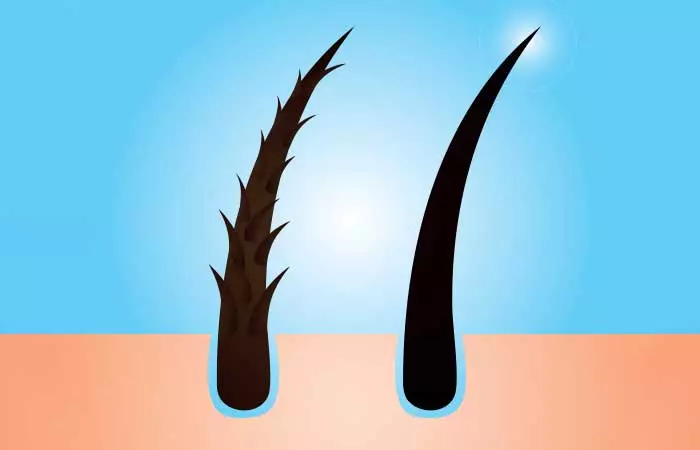
Before we get into what causes them, let’s answer a more important question – what are split ends? Your hair strands begin to develop split ends when the hair cuticle (outer protective sheath) gets damaged and begins to wear off. This leads to the delicate inner layer of your hair getting exposed and weakened or dehydrated, which, in turn, causes split ends (1).
 Fun Fact
Fun FactUnfortunately, there are a ton of factors that could be contributing to your split ends malady. While you could blame some of it on the harsh environment that you subject your hair to every time you step out of the house, you also need to take a long, hard look at how you yourself are treating (or rather, mistreating) your hair. So, here are a few of the most common factors that lead to hair damage and split end –
- Detangling your hair aggressively when it is dry (1)
- Detangling your hair when it is wet (1)
- Sun damage caused by stepping out in the sun without covering your hair (1)
- Using heat styling tools like straightening irons, curling wands, and blow dryers excessively (1)
- Not trimming your hair regularly
- Not conditioning your hair regularly
- Washing your hair daily (1)
- Undergoing chemical treatments like hair color, relaxers, and perms (1)
- Using too many styling products like gels, mousses, waxes, hair sprays, etc.(1)
- Using cheap quality synthetic brushes, combs, and other hair tools and hair products
- Sleeping on rough or cheap quality pillowcases
- Unhealthy diet and not getting enough proteins, minerals, and vitamins
Split ends can be categorized into different types based on their appearance and other characteristics. Check out some of the common types of split ends in the next section.
Key Takeaways
- Split ends occur when the outermost cuticle layer begins to wear off.
- Aggressive hair brushing, heat styling tools, and the lack of a nourishing hair routine can lead to split ends.
- You can trim your split ends using the hair twisting or hair sliding methods if your hair length is enough to twist and hold.
- Another easy way to get rid of split ends is by trimming off the ends of your hair.
- Deep conditioning your hair and air drying it can help prevent split ends.
Common Types Of Split Ends
Split ends are one of the earliest signs of hair damage and different types of split ends require different treatments. Thus, understanding more about them helps you prevent them from happening and ensures you choose the most effective remedies. Take a look at some of the common types below:
- Basic Split End: It is formed when a hair strand splits into two separate strands at the end and creates a Y-shaped appearance.
- Feather Split End: It is formed when a hair strand separates into multiple smaller strands, giving a feathered or frayed appearance.
- Tapered Split End: It is formed when a hair strand gradually thins toward the end, making it look like the hair is fading away.
- Knot Split End: It is formed when a small, tight knot forms at the end of a hair strand, leading to breakage.
Instead of wondering how to cut off these different types of split ends, start with baby steps: trimming your split ends. Here is why you need to do it.
Why Do You Need To Trim Split Ends?
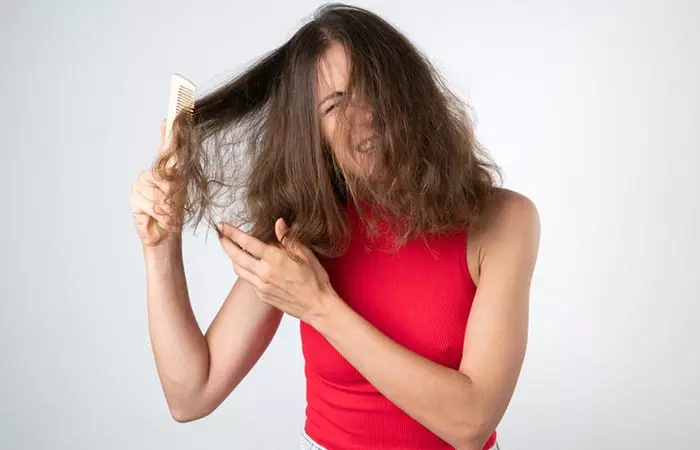
Besides making your hair look dull, damaged, and lifeless, there are a ton of reasons why letting your split ends persist and leaving them untreated is a bad idea. Here are some easy hair maintenance tips you need to be aware of!
- Split ends don’t go away on their own: Split ends don’t just magically fuse back together when you start conditioning or taking care of your hair. In fact, the longer you put off trimming them, the more each end splits into 2 or 3 “feathers.” This, in turn, seriously hinders your hair growth.
- Uneven pigmentation: The color of split ends is usually a bit lighter than your natural hair color. This can make your overall hair color look discolored and uneven.
- Robs your hair of its shine: Split ends rob your hair of its lively glow and make it look brittle, dull, and lifeless. No amount of conditioning, hair masks, and spa treatments can restore the shine back in your hair unless you trim off the split ends.
- Causes more hair damage: Split ends travel up the hair strand over time and cause more damage. It is important to your hair to prevent further harm and give it a healthier, shinier appearance.
- Lead to breakage: Split ends cause hair to tangle more, leading to breakage. As a result, it becomes tough to retain hair length. When you trim these split ends, your hair becomes well-managed and can grow longer without any hindrance, giving you a cohesive look.
Rachel, a beauty blogger, shares a blog post talking about all her mistakes that led to an overwhelming amount of damage to her hair, one of them being negligence in trimming split ends. She says, “Whilst at uni, I went three months at a time without getting my hair cut, this lets any damage you have on the ends travel up the hair shaft, and leaving my split ends is one of the biggest mistakes I made (i).”
Carolyn, a hair care and styling blogger has a varying opinion to offer. She says split ends impact different people differently and that not all may incur hair damage because of it. “I’ve started doing what is known as SD or Search and Destroy on split ends. As I said, I’ve only been doing this for a few months and I’ve been able to grow my hair for years without doing anything about split ends (ii),” she says.
How To Trim Split Ends
The easiest, quickest and most convenient way of getting rid of split ends is by trimming them off. Now, wait a minute! Before you rush off to set up an appointment with your hairdresser, hear me out. You can easily trim off split ends yourself in the comfort of your home! All you need is a pair of hair cutting scissors and you’re good to go! There are 3 different methods that you can try out to get rid of split ends. Let’s look at each of them step by step.
I. Hair Twisting Method
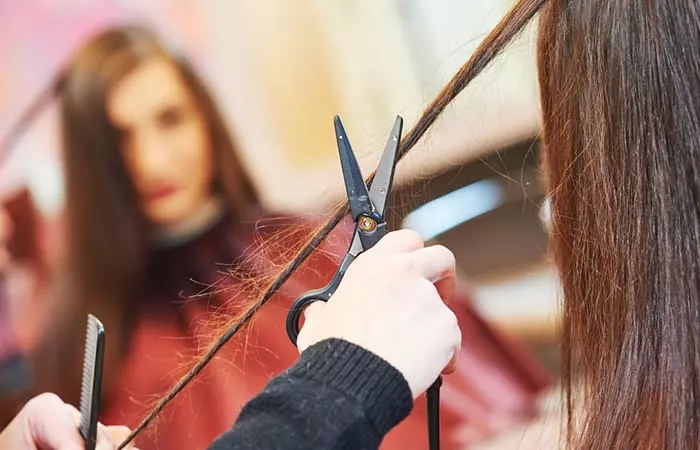
Hair twisting is a traditional method of trimming split ends and is actually the method even professional hairdressers use!
What You Need
- Hair trimming scissors
What To Do
- Start off with dry hair.
- Pick up a 1-inch section of hair and tightly twist it in a clockwise manner from the roots to tips. Hold this twisted section of hair taut at the ends.
- If you have twisted the hair tightly enough, you will see the split ends sticking out from the twisted section.
- Starting from the top of the section and working your way down, trim off these split ends that are sticking out.
- Now, re-twist this same section but in a counterclockwise direction and cut off the split ends in the same manner.
- Repeat this process throughout all your hair.
II. Hair Sliding Method
Hair sliding is a more unconventional method that not many people know about. This is probably because it requires a little more effort as you have to straighten your hair before you cut off the split ends.
What You Need
- Heat protectant
- Straightening iron
- Wide toothed comb
- Hair trimming scissors
What To Do
- Apply a heat protectant and straighten your hair. (You can obviously skip this step if you already have straight hair.)
- Use a wide-toothed comb to remove all the knots and tangles from your hair.
- Pick up a 1-inch section of hair.
- Starting at the roots, weave this section of your hair under your index finger, over your middle finger, and under your ring finger. Thus, you will see your hair only above your middle finger.
- Thanks to this weaving action, you will be able to see the split ends sticking out above your middle finger.
- Snip off these split ends with the hair trimming scissors.
- With the hair still remaining woven through your fingers, slowly slide your fingers down the section of hair and trimming off the split ends in the same manner.
- Continue this sliding and trimming motion until you have reached the end of the section. Then, just follow this same procedure all over your hair.
III. Trimming The Ends
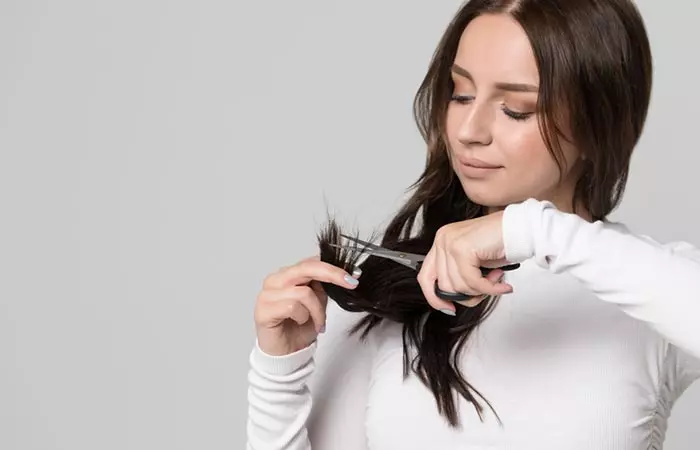
If you don’t have the time (or the patience!) to follow the twisting and sliding methods, you can simply trim off the ends of your hair to get rid of the split ends.
What You Need
- Hairbrush/wide-toothed comb
- Hair trimming scissors
What To Do
- Start off with damp hair. You can do this immediately after you’ve stepped out of the shower or dampen your hair with the help of a spray bottle.
- Brush out all the knots and tangles from your hair.
- Pick up a 1-inch section of hair. You can clip up the rest of your hair to keep it out of the way.
- Place this section of hair between your index finger and middle finger right at the roots.
- With the hair held taut between your fingers, slide your fingers down until you’re an inch away from the ends. Hold the section this way out in front of you.
- Keeping the scissors perpendicular to the hair, carefully cut off 1-2 inches off your hair.
- Trim off the ends of all your hair following this same procedure.
While it is fairly easy to snip off your split ends, you need to know that they are an indication of the poor health of your hair. So, it’s best that you start taking care of your hair, restoring its health to prevent split ends from developing in the future.
Ways To Prevent Split Ends
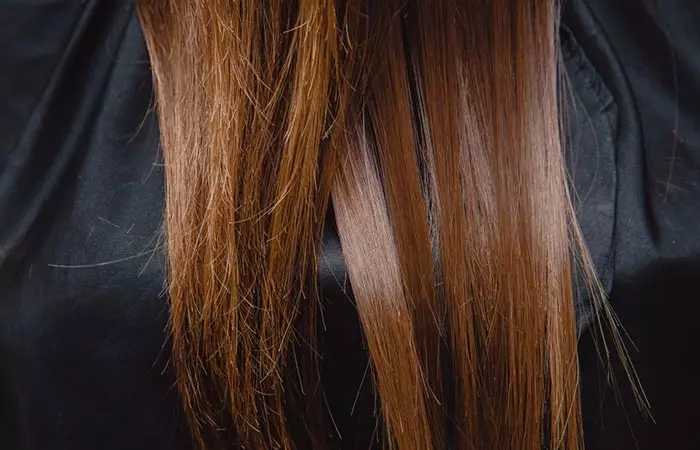
Yes, split ends can wreak havoc on your hair health and worsen your hair appearance. But, lucky for you, there are a ton of things that you can do to prevent them from forming in the first place. Here are a few tips and tricks that you can try out:
1. Trim your hair regularly: Your hair goes through some wear and tear every time you wash and comb it – this causes split ends (1). So, how often should you trim your hair? It’s best that you get your hair trimmed every 2-3 months and maintain this hair trimming frequency, no matter what.
2. Reduce use of heat styling tools: Regularly using heated hair styling tools like blow dryers, flat irons, and curling wands robs your hair of its moisture, affecting hair elasticity, and leaves it dry, brittle, and susceptible to split ends. So, avoid using them as much as you can, and when you do use them, make sure you apply a hair protection spray from heat to your hair first (1).
3. Don’t wash your hair every day and avoid using hot water: Doing either or both of these things can strip your hair of its natural oils and dehydrate and weaken it. Therefore, use gentle cleansers to maintain hair hygiene if you wash your hair too often.
4. Dry your hair gently: Vigorously rubbing your wet hair with a towel can cause intense damage and split ends. Instead, wrap your hair in a microfiber towel until it has absorbed all the excess water and let it air dry the rest of the way (1).
5. Apply a leave-in conditioner: Leave-in conditioners make your hair more manageable and easier to detangle, thus reducing the risk of split ends (1). So, apply a leave-in conditioner (or a bit of natural oil) after you step out of the shower for split end prevention.
 Quick Tip
Quick Tip6. Use a wide-toothed comb: Use a wide-toothed comb and work your way up from the ends towards your scalp to prevent further knotting, breakage, and split ends.
7. Wear a hat/scarf while stepping out: Leaving your hair exposed to the hot sun or cold winds can make it brittle and more prone to split ends. So, make sure you put on a hat or wrap a scarf around your head to protect your hair while making a cool fashion statement.
8. Deep condition regularly: It’s important that you deep condition your hair every 2 weeks to restore moisture into your hair and nourish it from within (1).
9. Use products that contain PEC: PEC or Polyelectrolyte Complex is a new component that has been found to repair split ends by penetrating the hair shaft and sealing it from within. So, pick a conditioner that contains PEC if you want to fix split ends as well as prevent them from forming (2).
10. Use soft hair ties: Rubber hair ties or ones that have a metal clasp in the middle tend to break your hair and ultimately lead to split ends. So, use soft hair ties that are gentle on your hair.
11. Oil your hair before swimming: Swimming regularly in harsh chlorine-infused water can cause untold damage to your hair. So, apply a protective layer of coconut oil all over your hair and put on a swim cap before you jump into the pool.
12. Eat a balanced diet and drink lots of water: Eating a balanced diet full of proteins, vitamins, and minerals and keeping your body well hydrated is essential for maintaining the health of your hair (3). These nutrients may nourish hair follicles and improve hair strength.
Infographics: 3 Hair Trimming Methods For Split Ends
Split ends are the most common hair-related problem across the world. They not only hinder the growth of hair but affect its luster and hair shine, leaving your hair dull. Split ends should be treated at the earliest, and trimming is the simplest solution to it. Scroll down to know more about hair trimming techniques and methods. Illustration: StyleCraze Design Team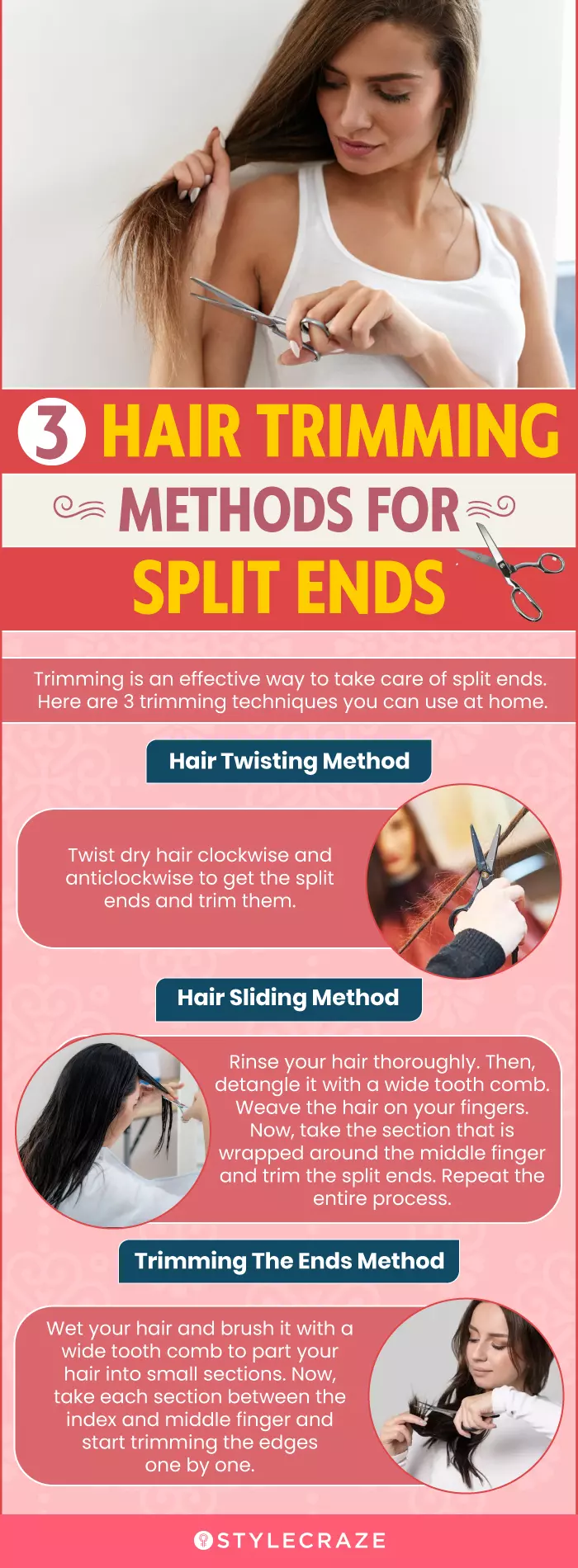
Your hair develops split ends when your hair cuticle is damaged which leads to weakened and dehydrated hair. Factors such as washing your hair every day, exposure to pollutants, having high hair porosity, and using harsh chemical products can leave you with split ends. That is why trimming your split ends is important because it gives you hair frizz and makes your hair look dry and dull. To spare the cost of an expensive hair treatment and haircuts in a hair salon, you can simply use a pair of hair shears and comb to cut your split ends. Trim your hair, condition your hair ends properly and eat a proper and healthy diet to ensure you don’t develop split ends any further.
Frequently Asked Questions
What can happen if you don’t cut your split ends?
Your hair can look dull and dry and your hair growth can slow down if you don’t cut your split ends.
Is it better to cut your hair when it’s wet or dry?
It’s better to cut straight hair when it’s wet and curly hair when it’s dry.
Do split ends slow down hair growth?
Yes, split ends do slow down hair growth.
Which haircut is best for split ends?
A textured look, complete with layers or waves, can help one temporarily deal with split ends.
Does trimming promote hair growth?
No, hair trimming does not promote hair growth. However, it helps get rid of split ends or damaged, frayed parts of the hair. Your hair would look healthier as a result.
Illustration: The Importance Of Trimming Split Ends
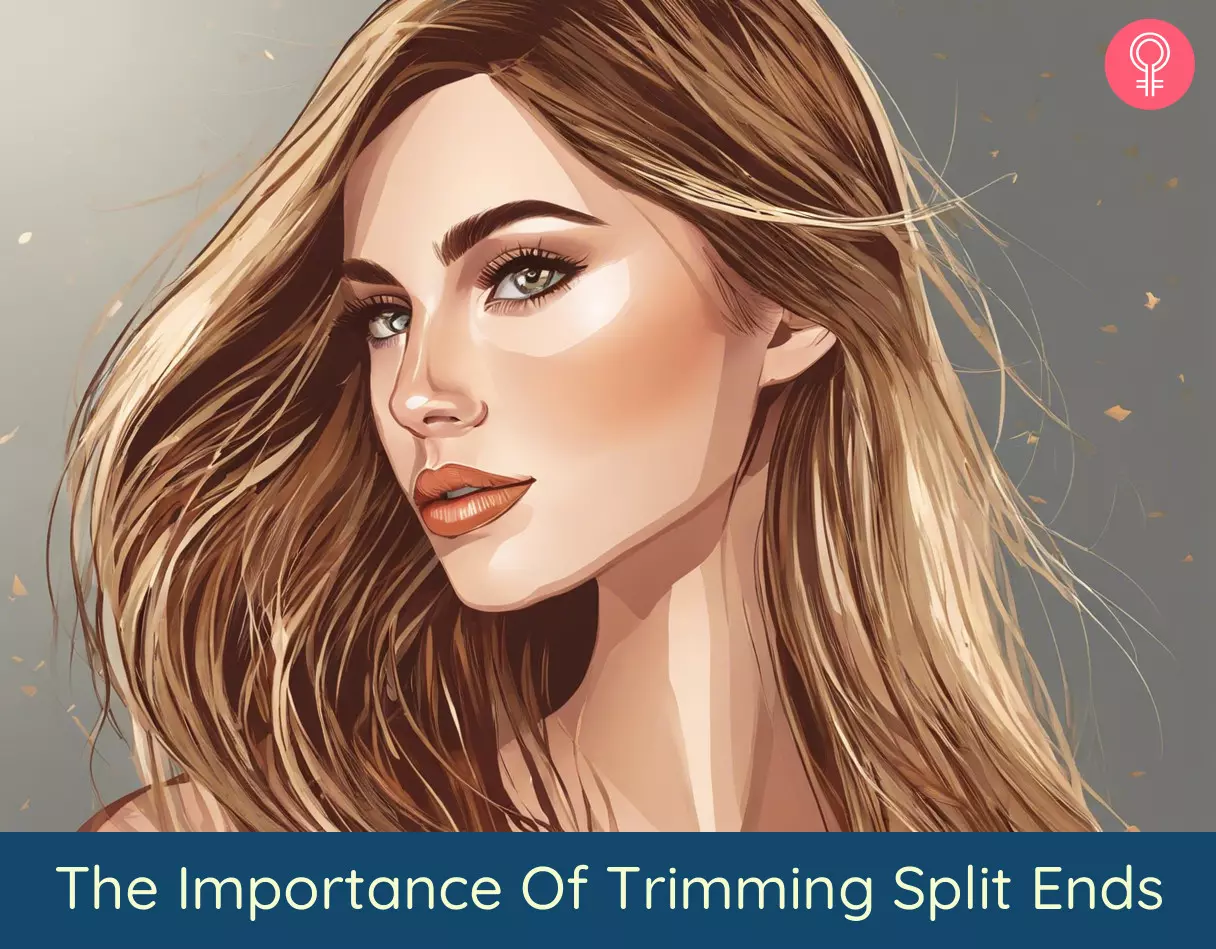
Image: Stable Diffusion/StyleCraze Design Team
Are split ends really that bad? Is it really necessary to trim your hair? Get the truth about trimming your split ends in this video!
Personal Experience: Sources
StyleCraze's articles are interwoven with authentic personal narratives that provide depth and resonance to our content. Below are the sources of the personal accounts referenced in this article.
i. My Hair Story – How I damaged my hairhttps://rachwat.wordpress.com/2014/07/25/my-hair-story-how-i-damaged-my-hair/ii. What Happens If I Never Trim Split Ends?
https://longhaircarolyn.medium.com/what-happens-if-i-never-trim-split-ends-90f963e0409c
References
Articles on StyleCraze are backed by verified information from peer-reviewed and academic research papers, reputed organizations, research institutions, and medical associations to ensure accuracy and relevance. Read our editorial policy to learn more.
- Hair Cosmetics: An Overview, International Journal Of Trichology, US National Library Of Medicine, National Institutes of Health.
https://www.ncbi.nlm.nih.gov/pmc/articles/PMC4387693/ - Semi Permanent Split End Mending With A Polyelectrolyte Complex, Journal Of Cosmetic Science, US National Library Of Medicine, National Institutes of Health.
https://pubmed.ncbi.nlm.nih.gov/17728946/ - Diet And Hair Loss: Effects Of Nutrient Deficiency And Supplement Use, Dermatology Practical And Conceptual. US National Library Of Medicine, National Institutes of Health.
https://www.ncbi.nlm.nih.gov/pmc/articles/PMC5315033/
Read full bio of Dr. Madhuri Agarwal
Read full bio of Arshiya Syeda
Read full bio of Ramona Sinha
Read full bio of Monomita Chakraborty






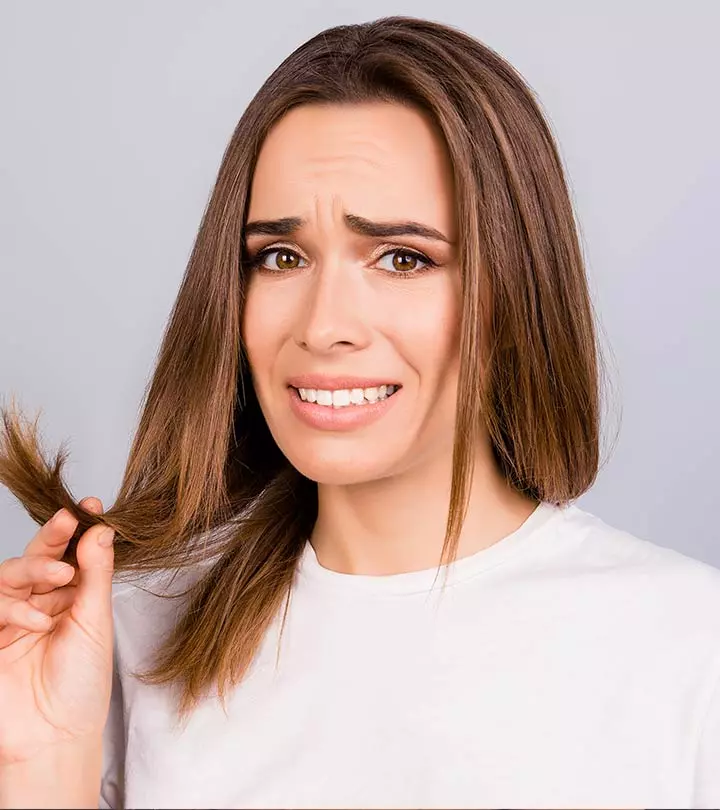
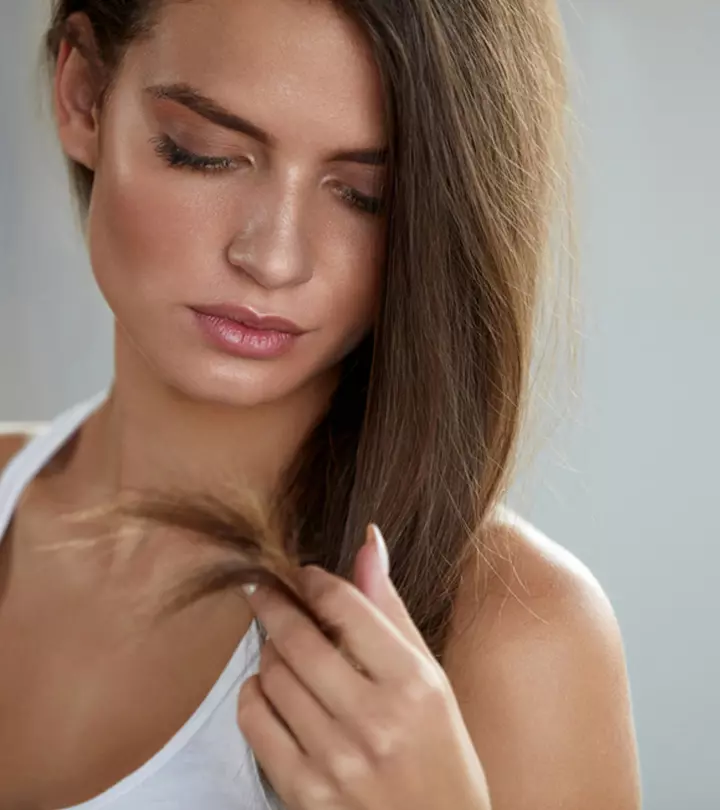
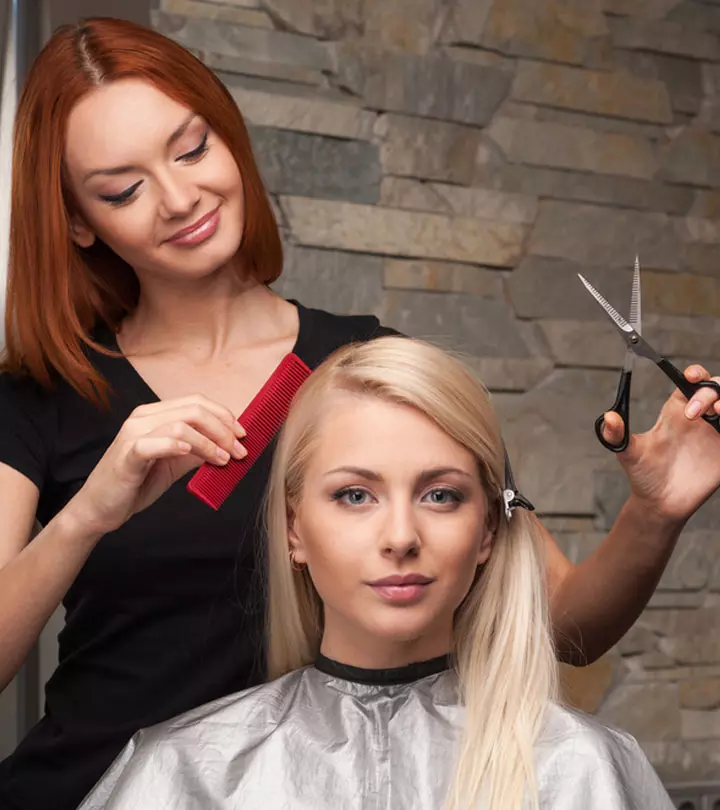

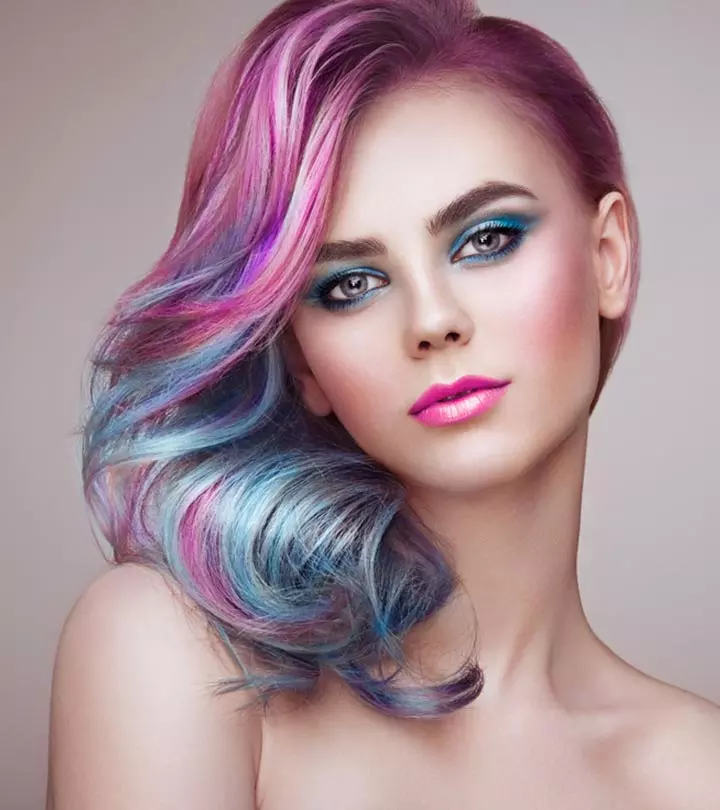
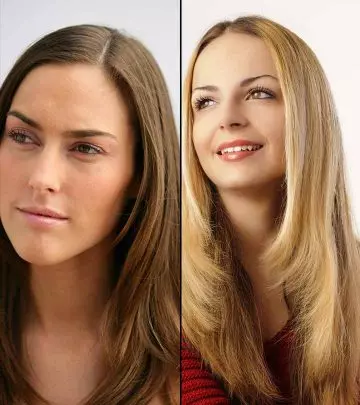
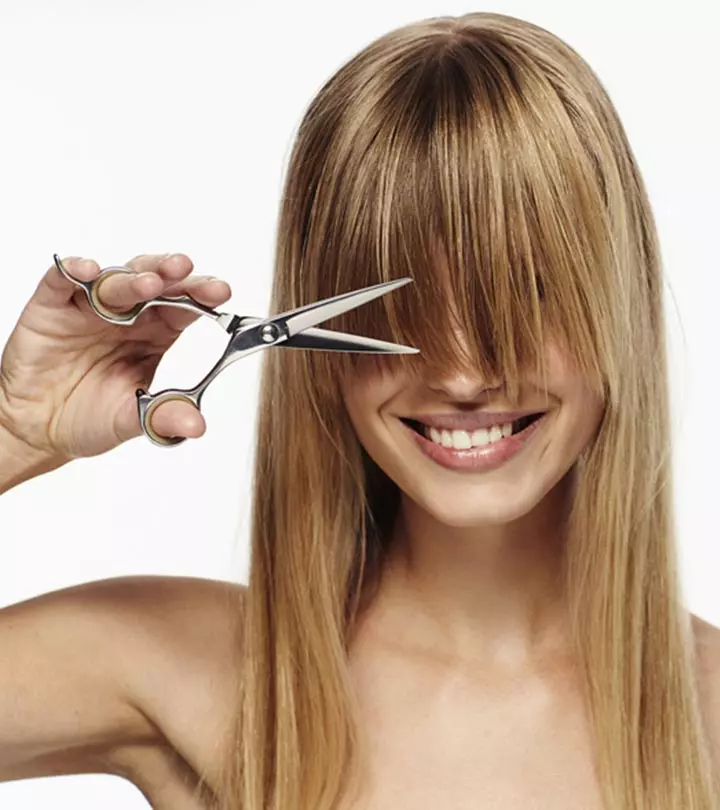
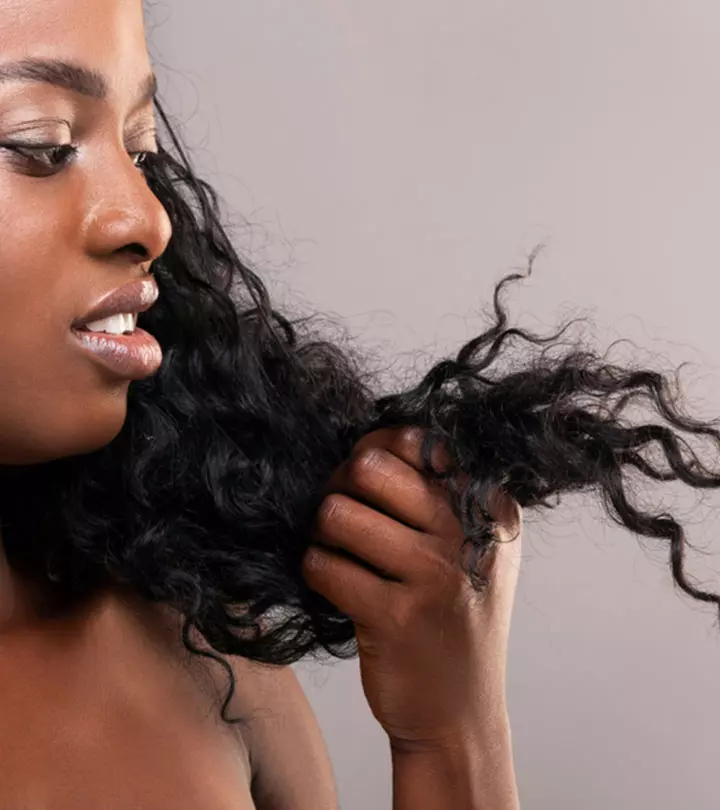



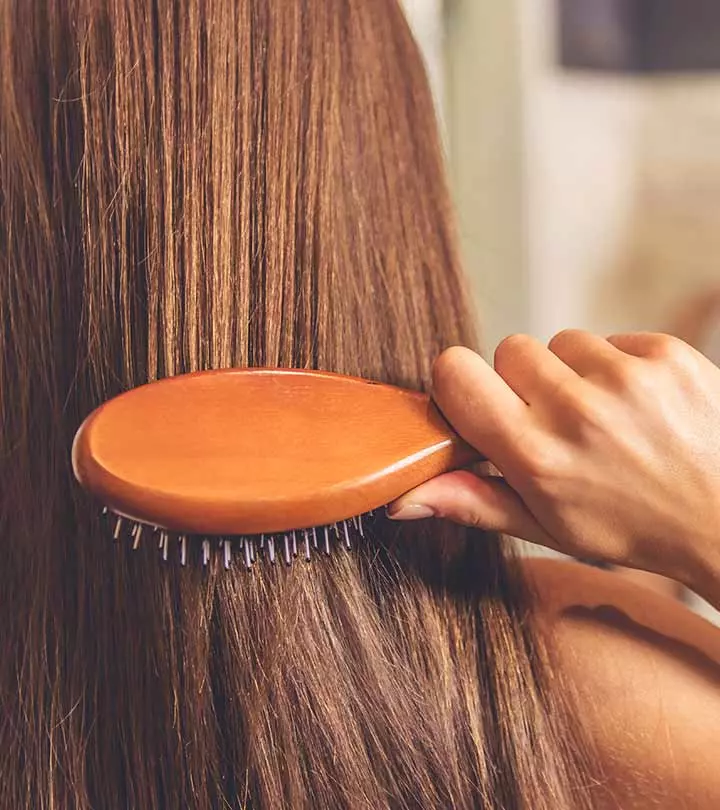
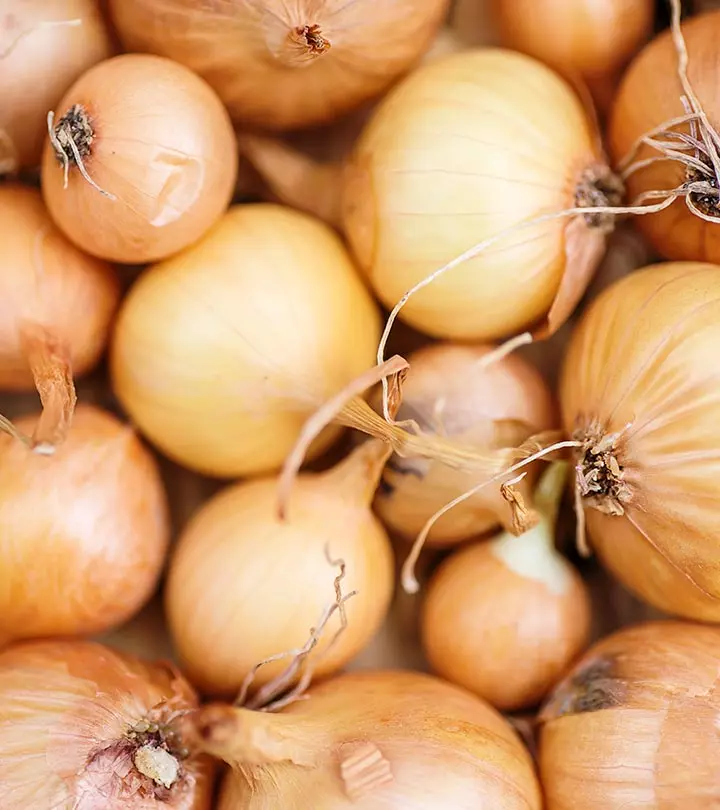


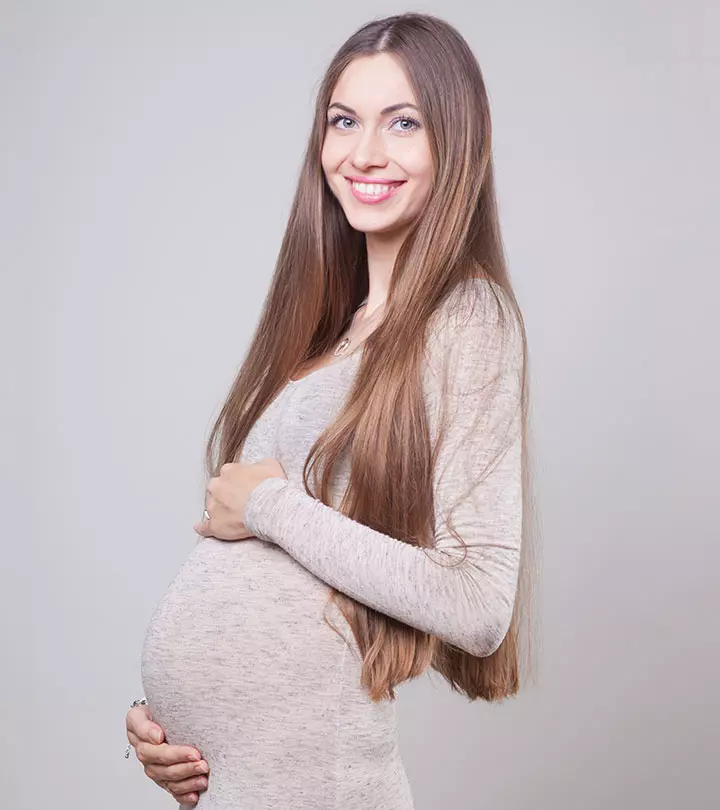


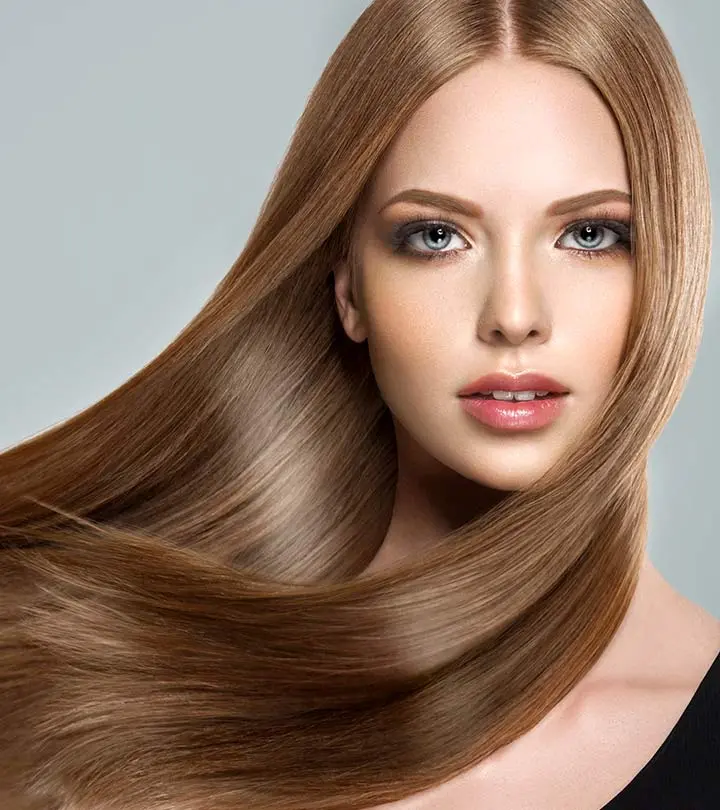
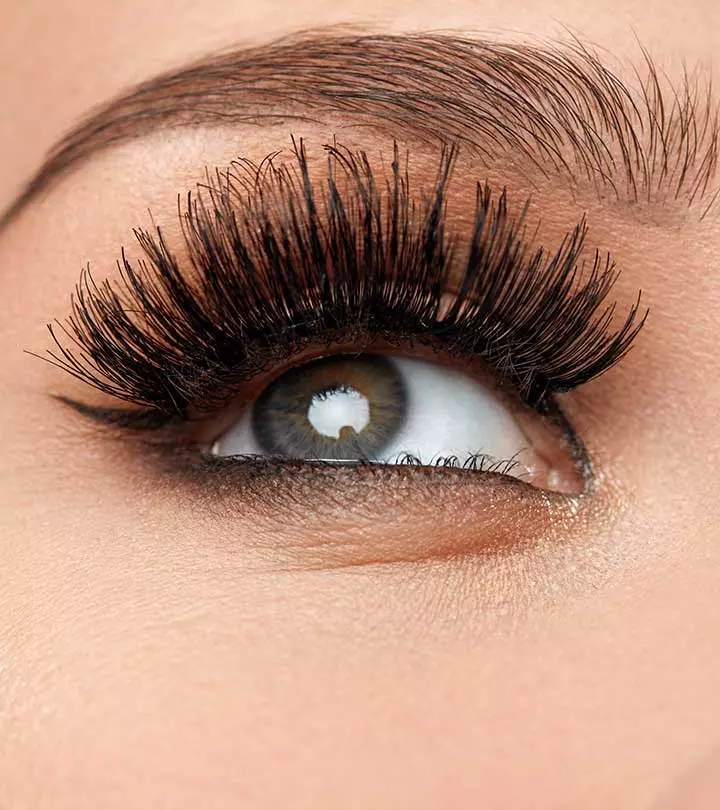
Community Experiences
Join the conversation and become a part of our empowering community! Share your stories, experiences, and insights to connect with other beauty, lifestyle, and health enthusiasts.